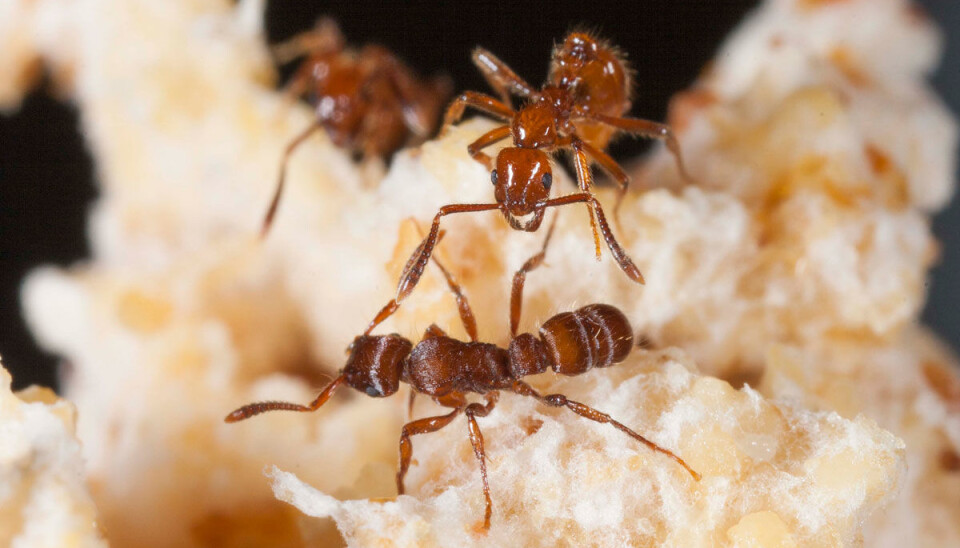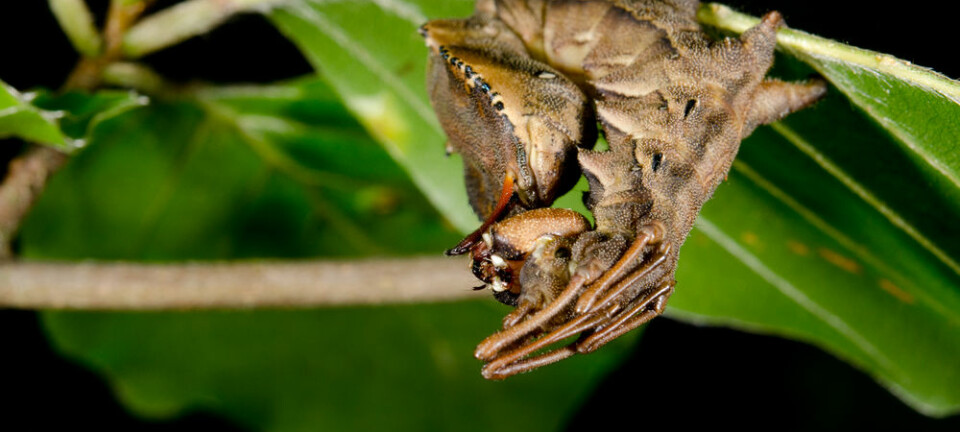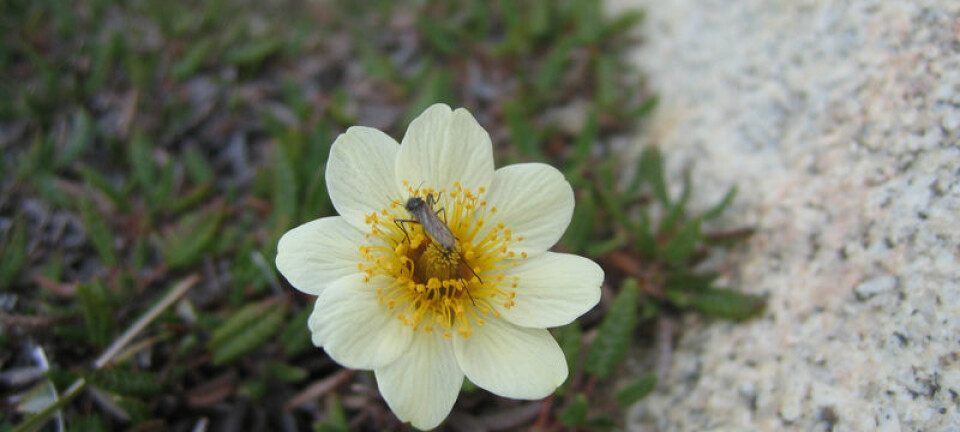
Ants in gladiatorial combat reveal unique collaboration
Defenceless ‘farmer ants’ receive help from heavily armed venomous ants when their colony is attacked. This unique collaboration has now been documented through gladiatorial combat between the ants.
The fungus-growing ants of the genus Sericomyrmex, which live in Central and South America, manage their own agricultural system in small chambers underground.
Here, the ants grow fungi on rotting plant residues that the worker ants bring into the colony. These nutritious fungi supply the entire colony with food.
Not surprisingly, other ants have noticed this cornucopia of delights hidden deep inside the fungus-growers’ colony.
These include the parasitic guest ant of the genus Megalomyrmex and a raiding agro-predator of the genus Gnamptogenys.
Ant species coexist in harmony
When the colony is attacked by e.g. predator ants like the Gnamptogenys, the fungus-growers escape down to the bottom of the colony where they hide while the parasitic ants storm up towards the surface to defend the colony against the predators.
A new study shows that rather than fighting for the nutritional goodies, the fungus-growing ants and the parasitic guest ants entered into a unique collaboration, which benefits both parties.
”The two ant species have found a way of coexisting in the same colony. The fungus-growers grow food for both species, while the parasitic guests defend the colony against predator attacks,” says postdoc Rachelle Adams of Copenhagen University’s Department of Biology.
“This is a very special form of collaboration that we haven’t seen before, and that makes it interesting to study.”
Adams is the lead author of the new study, published in the journal PNAS.
Queens team up to form colonies
The parasitic ants’ poison is a very powerful weapon to which the predator ants are defenceless. My experiment showed that when the fungus-growers have parasitic guest ants in their colony, they also have a highly competent military force for when the colony needs to be defended.
The cooperation between the two ant species starts at the early stage when the colony of fungus-growing ants consists of nothing but a queen ant and her own little fungi garden.
At this point, the colony is invaded by a parasite ant queen, leaving the fungus-growing queen with the choice of either attacking the intruder or allowing the uninvited guest to eat from her fungi garden.
In fact, the fungus-growing queen wouldn’t be able to defend herself against the poisonous sting of the parasite ant.
The fungus-growing queen therefore allows the parasitic guest queen to move in on her territory, while the parasitic guest queen remains there as long as she tends the garden – and this is the start of a unique collaboration.
”This is how two queens start up a colony together. They can coexist for years and each species rears its own offspring,” says Adams.
Both species benefit
There is something in it for both ant species. The parasitic ants don’t need to find their own food. They just grab whatever they need from the fungus-growers’ garden. Occasionally, they also snatch a bit of the fungus-growers’ offspring to add some variation in their diet.
The fungus-growers benefit from this collaboration in that the parasitic ants act as a defensive army that can keep out predators.
The fungus-growers are not poisonous, and their only defence consists of a relatively impotent set of jaws that it uses to munch on leaves. Their cooperation with the parasitic ants forms a strong defence when the colony is attacked.
“When the colony is attacked by e.g. predator ants like the Gnamptogenys, the fungus-growers escape down to the bottom of the colony where they hide while the parasitic ants storm up towards the surface to defend the colony against the predators,” explains the researcher.
Gladiator fights in ant trials
In her study, Adams carried out a series of experiments to figure out how much of an advantage the fungus-growers get from having the parasitic ants squatting in their colony.
The experiments are rather similar to gladiatorial combat between humans.
In an early trial, the researcher let a single predator ant fight to the death with two, three, four, six or eight fungus-growing or parasitic ants.
The trial revealed that the fungus-growers could only defend themselves against the predators when the ratio was at least eight fungus-growers per predator. In all other cases the predators slaughtered the fungus-growers, whose only defence, their jaws, had been rendered useless.
The parasitic guest ants, on the other hand, put up much more of a fight. It only took two parasitic ants to kill a predator ant.
”The parasitic ants’ poison is a very powerful weapon to which the predator ants are defenceless. My experiment showed that when the fungus-growers have parasitic guest ants in their colony, they also have a highly competent military force for when the colony needs to be defended.”
Parasitic guest ants save lives
Another experiment had a more realistic design.
Here, she let 18 fungus-growers defend themselves against two predator ants. The fungus-growers received assistance from either zero, three or six parasitic ants.
The experiment showed that the greater the number of parasitic ants in the colony, the fewer deaths among the fungus-growers when the colony is attacked.
”It looks as if the parasitic ants do not only defend the colony, but also the fungus-growers,” says Adams.
Fungus-growers let the military do the fighting
After the bloody fights between the three ant species, the researcher wanted to see to what extent the fungus-growers took part in the actual battle when parasitic ants were present, compared to when they had no parasitic ants to defend them.
She collected the fallen predator ants and examined the injuries they had sustained during the fighting.
Adams hypothesised that parasitic ants only kill with their poisonous sting, so the predator ants would not have any visual injuries from the fighting if they were killed by the parasitic ants.
Since the fungus-growers can only attack with their jaws, it was concluded that predator ants that had fallen in battle with a fungus-grower must have lost some limbs during the fight.
”The experiment showed that the predator ants had lost several limbs when there were no parasitic guest ants to defend it," she says. "This means that the fungus-growers defend the colony when there are none or few parasite ants to do it for them. When there are parasitic ants, the fungus-growers can walk away from the battle zone and leave the fighting to those who can actually fight.”
----------------------
Read the Danish version of this article at videnskab.dk
Translated by: Dann Vinther







